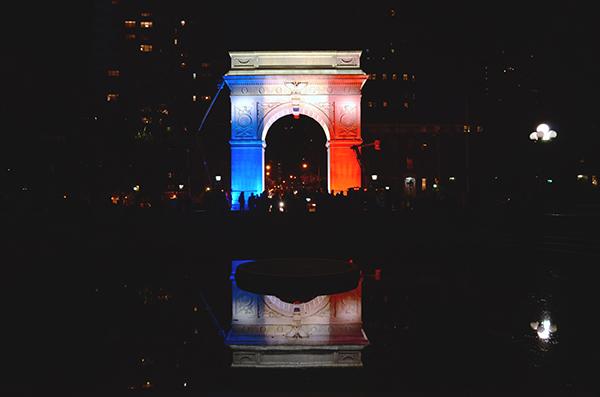New HBO Doc Revisits Charlie Hebdo Attacks

The Washington Square Arch was lit up to mirror the flag of Paris following last year’s attacks on the Charlie Hebdo headquarters. A new HBO documentary looks back on the tragic days.
September 22, 2016
In the early days of January 2015, Paris and the rest of the world were gripped with fear from a frightening series of extremist terrorist attacks. The first of these attacks took place in the offices of Charlie Hebdo, a satirical news publication that had produced comedic cartoons caricaturing the Prophet Muhammad. From this attack, which claimed the lives of 11 people at the office that day, sprang a series of related incidents around Paris over the following week.
Through the use of cellphone footage, security camera photographs, crime scene evidence and exclusive interviews with both witnesses and law enforcement officials, producer/director Dan Reed paints a harrowing and intense picture of these attacks in the HBO documentary “3 Days of Terror: The Charlie Hebdo Attacks,” focusing on the emotions that those involved went through. The documentary is made even more harrowing when one acknowledges that the peace achieved at the end of the film was only temporary, and is still being threatened to this day.
Since it squeezes a number of events into the span of a one-hour documentary, the film is incredibly fast-paced and focused. Nearly all of the documentary takes place within the span of the titular three days. There is little time reserved for history or a brief background of the recent events regarding terrorism, though exploring the various motivations behind the attacks would have helped to give some context to the footage.
However, what “3 Days of Terror” lacks in context, it makes up for in terms of sheer emotional power and intensity. The events are explained with incredible attention to detail by both the people on the inside and the law enforcement that risked their lives to try to save them. Reed uses incredibly tight close-ups on his interview subjects — thus, as they recall the horrifying and tense moments of the attack, their emotional nuances are placed front and center for the viewer. Even those who did not wish to be named or have their faces featured in the film are shown with the camera lingering closely on a neck or an ear so that their subtle body language is not lost.
Along with these interviews, Reed uses a variety of other sources to provide the viewer with a sense of what happened. In the beginning portion that focuses on the attacks at the Charlie Hebdo offices, Reed uses footage taken on the building’s rooftop by a man who worked at the production office down the hall. He also splices in photos taken by security cameras, telephone call audio and videos taken from across the street. This allows the viewer to see the event from all sorts of physical and emotional angles. Viewers can clearly understand the locals’ frustration with the police for not immediately capturing the attackers, but also the guilt felt by the man in the production office who regrets not calling and warning the victims.
“3 Days of Terror” is excellent at exploring the various feelings and actions that such horrifying events can instill in those who experience them. While the events that it highlights are indeed bleak and resulted in devastating loss, they are also examples of the courage and humanity that can reside inside anybody, whether they are a sniper in the gendarme or a cashier at a kosher supermarket.
“3 Days of Terror: The Charlie Hebdo Attacks” premiered on HBO on Monday, Sept. 19.
Email Spencer Nachman at [email protected].
























































































































































